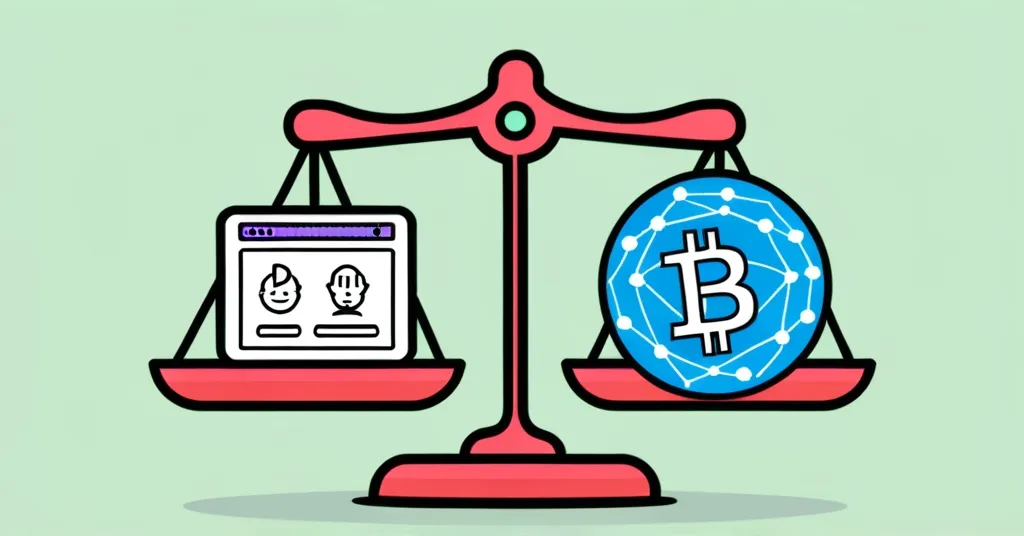DeFi’s Secret Third Option: Combining UX and Decentralization

The Secret Third Option in Decentralized Finance
In the world of finance, the narrative often pits the user-friendly allure of centralized platforms against the rugged transparency of decentralized finance (DeFi). But what if there’s a third way? Karel Kubat, co-founder of Union, asserts that DeFi can indeed deliver both a robust user experience (UX) and uphold its core principle of decentralization.
- Decentralization and UX are not mutually exclusive in DeFi.
- Centralized failures highlight the risks of sacrificing transparency.
- Smart contracts and Layer-2 solutions are improving DeFi UX.
The Myth of UX vs. Decentralization
Karel Kubat challenges the prevailing notion that in DeFi, achieving a strong UX necessitates some degree of centralization. He argues,
“There’s a false—and, I would argue, dangerous—belief that in DeFi, strong UX can’t be achieved without some degree of centralization.”
Centralized platforms like Coinbase and Binance may boast intuitive interfaces, but they often operate with a veil of opacity and pose security risks, as evidenced by the high-profile collapses of Three Arrows Capital, Celsius, and FTX.
Yet, it’s not all doom and gloom in the realm of centralization; the devil’s in the details. These platforms might be slick, but they’re often as transparent as a brick wall. Let’s be real: when your money’s on the line, you want to know where it’s going, not just trust some shadowy entity’s word for it.
Centralized Failures: A Cautionary Tale
Consider the saga of Three Arrows Capital, Celsius, and FTX. Their downfall was a stark reminder that centralization can lead to user losses and undermine trust. In contrast, decentralized protocols like Aave, operational since 2017, showcase the potential for both transparency and a viable user experience. Kubat emphasizes,
“Decentralization cannot—and doesn’t need to be—sacrificed for a smoother user experience. DeFi can—and must—have both.”
Even when decentralized systems like Terra stumbled in 2022, they did so with a level of transparency that allowed users to grasp the situation better than with centralized counterparts.
But let’s not get too starry-eyed. Even the most ardent Bitcoin maximalist would admit that decentralized systems aren’t perfect. The collapse of Terra showed that while transparency is a virtue, it’s not a magic shield against failure. What it does offer, though, is a chance for the community to rally, understand, and rebuild.
Innovations in DeFi: Enhancing User Experience
DeFi’s UX challenges stem from its relative youth compared to the well-trodden paths of web2. However, the sector is not sitting idly by. Innovations such as smart contract enhancements and Layer-2 solutions are paving the way for a better user experience. Think of smart contracts as financial vending machines, automatically executing transactions when conditions are met. And Layer-2 solutions? They’re like adding express lanes to a highway, improving scalability and user experience on blockchains. For instance, Uniswap’s wallet and Unichain L2 are strides toward making DeFi more accessible and responsive without diluting its decentralized essence.
As much as we champion Bitcoin, it’s crucial to acknowledge that altcoins and other blockchains like Ethereum have their roles to play. They’re not just rivals; they’re collaborators in the quest to refine DeFi’s UX and reach niches that Bitcoin might not serve as effectively.
The Future of Finance: Demanding Both Convenience and Security
Kubat’s efforts with Union, a fully trustless bridge powered by zero-knowledge technology (a secure, private way to move assets between different blockchains without needing to trust a third party), underscore his commitment to interoperability, security, and trustlessness in web3. He believes,
“The future of finance shouldn’t involve choosing between centralized convenience and decentralized security. We need to demand both.”
DeFi aims to streamline financial processes that often bog down traditional finance (TradFi), offering greater interoperability, transparency, and user control.
In the broader context, the crypto community is wrestling with the fallout of centralized failures, pushing for enhancements in DeFi’s usability while preserving its decentralized ethos. The ongoing advancements through smart contracts and Layer-2 solutions signal a promising path forward, one where users don’t need to compromise on security for convenience.
While we celebrate these advancements, let’s keep a critical eye on the hype. Shameless price predictions and fake shilling are the bane of our existence. We need to keep our feet on the ground, even as we reach for the stars.
Key Questions and Takeaways
- Can DeFi achieve a strong user experience without compromising decentralization?
Yes, through ongoing improvements like smart contract enhancements and Layer-2 solutions, DeFi can enhance UX while maintaining its decentralized nature.
- What are the risks of centralization in the crypto space?
Centralization risks include opacity, unreliable practices, and significant user losses, as demonstrated by the collapses of Three Arrows Capital, Celsius, and FTX.
- How does transparency in decentralized systems benefit users?
Transparency allows users to have insights into transactions and hold systems accountable, reducing the risk of hidden fraudulent activities.
- What challenges does DeFi face in improving UX?
DeFi’s challenges include its relative youth compared to web2, as well as issues related to scalability, fragmentation, and compliance.
- How does DeFi compare to traditional finance in terms of user experience?
DeFi aims to simplify processes that are complex in TradFi, offering greater interoperability, transparency, and user control, though its UX is not yet as smooth as web2 interfaces.
As we navigate the evolving landscape of finance, the secret third option in DeFi—a world where both convenience and security coexist—may just be the key to unlocking a more inclusive and efficient financial future. Let’s keep pushing for a DeFi ecosystem that doesn’t just disrupt but also delivers on the promise of a better financial world.


